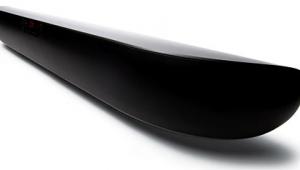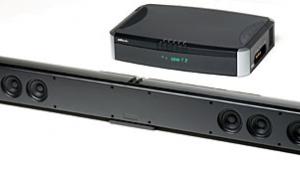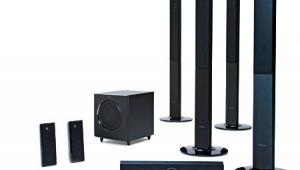Dreaming the Not-Impossible Dream Page 4
The sense of three- dimensional, sound-bubble coherence was complete and effortless, with the surround speakers obviously contributing to the field but not making their physical presence apparent, thanks to what is clearly a superbly designed, smoothly dispersive tweeter.
I’m not going to go through a laundry list of explosion-rich movies auditioned to demonstrate this powerful system’s obvious ability to play incredibly loud, go remarkably deep, produce enormous dynamic swings, and keep a tight grip on the proceedings throughout, but trust me, in terms of those tasks, and especially in terms of transparency and three-dimensionality, I haven’t heard a more capable system, at least not in my room.
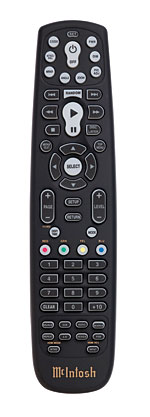 Here, if the McIntosh system errs in any direction, it would be toward a leanness in the lower midrange/upper midbass, producing a slight lack of warmth that emphasizes, in a piano, for instance, the percussive transient of the hammer on the strings as opposed to the resulting sounding-board resonance, giving the instrument a somewhat lean overall texture. Likewise, an acoustic guitar would be more about the percussive strum than the resulting woody resonance.
Here, if the McIntosh system errs in any direction, it would be toward a leanness in the lower midrange/upper midbass, producing a slight lack of warmth that emphasizes, in a piano, for instance, the percussive transient of the hammer on the strings as opposed to the resulting sounding-board resonance, giving the instrument a somewhat lean overall texture. Likewise, an acoustic guitar would be more about the percussive strum than the resulting woody resonance.
Implementing Audyssey room correction in my space with other systems usually reduces an attractive, well-controlled, narrow-Q, low-frequency excess, but running Audyssey this time seemed to actually fill in the missing warmth. However, the trade-off was a loss of the system’s incredible transparency, crystalline clarity, and subjective phase coherence. Therefore, I mostly left it off.
The Musical Component
Some movie enthusiasts probably would spend $34,000 just to be blown out of their seats by a capable assemblage like this, both for its sonic performance and its high bling factor. Even after a month, I found looking at it almost as pleasurable as listening to it.
Given its heritage, you’d hope this system would impress more with music than with cinematic sound effects, and regardless of your sonic tastes, I think you’d find the musical proceedings startlingly excellent—even if your preferred sound is somewhat more Town Car-ish.
Did you watch The Grammys this year? The show concluded with one of the greatest Grammy performances I’ve seen. At the piano, Paul McCartney, accompanied by his trio and a sumptuous string section, performed a shortened version of the album-closing medley from Abbey Road, beginning with “Golden Slumbers.” When it came time for “The End,” McCartney stepped away from the piano and joined, guitar in hand, bandmates Rusty Anderson and Brian Ray, who were met on stage by Bruce Springsteen, a remarkably fit-looking Joe Walsh, and Dave Grohl. They traded squealing mini guitar solos choreographed by a finger- pointing McCartney, while monster drummer Abe Laboriel, Jr. pounded the spit out of his drum kit.

Have you ever sat in a large venue fitted with a state-of-the-art sound system and heard and felt the power of a well-miked drum kit—particularly the kick drum—actually pressurize an enormous space? This was the first time I experienced that sensation at home.
I cranked it up pretty loud (thankfully, my wife was at the Westminster Kennel Club Dog Show that night). The intensity of the compressed slap and release combined with the bass drum’s power-body slam and as perfectly rendered a crunchy snare and crackling cymbal as you’re likely to ever hear from a television show, absolutely sent me over the sonic moon!
I liked it so much I watched it repeatedly, measuring the SPL peaks in excess of 110 decibels; I could have played and enjoyed it even louder but that would have been insane. Luckily, I recorded the show on a high-definition D-VHS recorder (another great failed format I happily adopted). But when I watched it again on my reference system after this one had been packed up and shipped away, it turned into a sonic nightmare!

Don’t get me wrong. My reference system is very good, and costs more than $15,000. And the Grammy segment sounded OK, but it was more Town Car-squishy compared to the McIntosh system’s dynamic thrust, rhythmic certainty, and incredible transparency. The entire body-slam sensation was gone! The sense of a single, bristling-with-energy, organic, transient wallop transmitted with each pound of the kick drum was completely missing. Turning up the volume only amplified the disappointment—not that this aspect of musical reproduction is the most important. It’s not. It’s just important.
Higher-Resolution Audio
Viewed on an 100-inch Stewart screen through a JVC DLA-HD750 projector, I can’t honestly say I saw a noticeable improvement in picture quality over my inexpensive Blu-ray Disc player. Perhaps the MVP891 measures better, and perhaps in a direct A/B test it might look better (or maybe I’m just not as sensitive to it), but the viewing experience did not produce a wow factor similar to the listening one. However, the MVP891’s sonic performance was something else.
CD after CD, comparisons between the HDMI digital output with D/A conversion performed by the MX121 versus that of the player’s own digital-to-analog converters run balanced to the control center demonstrated the player’s sonic superiority. Not that the MX121 wasn’t accomplished as well; it just wasn’t as refined.
The MX121’s onboard DACs produced somewhat darker and thicker sound. By comparison, the MVP891’s rendering of familiar material produced an airier, more dimensional soundstage upon which were more subtly drawn images, particularly in terms of transient delicacy and transparency.
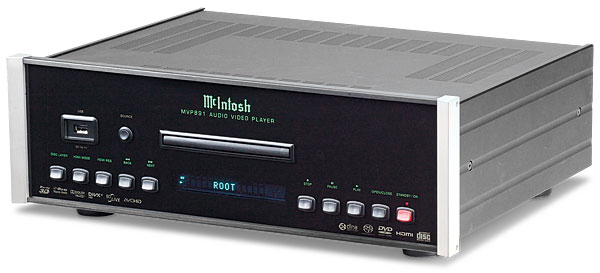
These are differences perhaps only a dedicated audiophile might pick up or even care about, but they were consistently heard and appreciated. Surprisingly, the MVP891 was able to play an old, defective Mobile Fidelity gold CD of Traffic’s eponymous second album that, due to flaking, had up until then been unplayable on other machines I’d tried.
Space doesn’t permit more detail here, other than to say that the MVP891 was a superb-sounding digital-audio player on CD via its balanced outputs, as well as on DVD-Audio discs through its single-ended, 7.1-channel, analog outputs. Via the balanced output, Neil Young’s 192 kHz/24-bit, two-channel, Archive DVD-Audio disc sounded better than I’ve ever heard, and if you prefer the balanced output and don’t mind a two-channel mixdown, the player will automatically perform it.
As for SACD, I have two copies of Beck’s brilliantly recorded Sea Changes, so I put one in the MVP891 and one in my Sony SACD player and did direct A/B testing. While the Sony was somewhat softer, smoother, and mellower, and the MVP891 punchier and better defined, I can’t say I preferred one to the other. They just sounded different. I happily sat through the MVP891’s playback of Analogue Productions’ 5.1-channel SACD of Pink Floyd’s Wish You Were Here, and other than nearly hitting the ceiling when, at one point, a voice mixed to the right-rear channel surprises the listener, the sound had all of the smooth flow I expect from DSD.
Conclusions
I hope you’ll get an opportunity to hear this McIntosh dream system under reasonably good circumstances—whether or not you can afford it. I can’t help but think you’d wish you could, although perhaps not if you’re the Town-Car type.
Before the system was fully disassembled, I substituted my reference Sonics speakers. These metal-cone and -dome speakers could hardly be characterized as being soft or romantic, yet compared to the XR100 loudspeaker system, they were. Still, despite their tonal honesty, the XR100 assemblage was neither bright nor hard sounding—unless the recording was.
At $16,500, this system, with its five well-engineered, surprisingly compact, and attractively finished speakers, actually strikes me as a good value, considering what audiophile speakers sell for these days.
I’d probably put the MC8207 amp in the high-value category, too, even at its $6,000 price point. It’s a rock-solid-sounding, high-power/high-performance, impeccably American-made amplifier that adds pride of ownership and bling factors that can’t be quantified. And McIntosh gear is notorious for holding value better than most.
If you want a player just to watch movies on DVD and Blu-ray Disc, I’m not sure you need to spend $5,500 for the MVP891 universal player, however. On the other hand, if digital-audio playback is important to you, the MVP891 is also a superior-sounding CD, DVD-Audio, and SACD player.
As for the MX121 control center, it lacks certain expected amenities like an HD tuner, satellite radio ports, a headphone jack, and front-mounted A/V inputs, so if those are important to you, you’ll have to look elsewhere.
Otherwise, although some of its functionality resembles that of the far less expensive Marantz upon which it is party based, it’s audio and build quality are more than a few significant steps up, especially in terms of subjective dynamics and signal-to-noise ratio. So why hesitate? What’s a few more dollars when you’re assembling a dream system, especially if you’re only dreaming?









